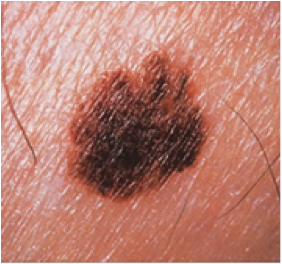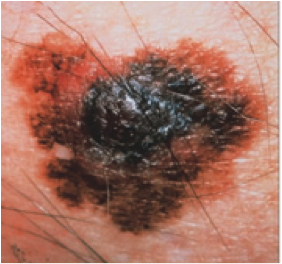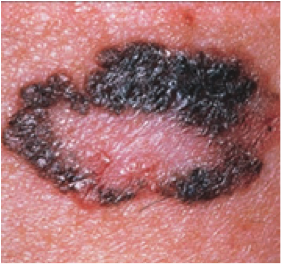Melanoma
Malignant melanoma is the most serious of all skin the common skin cancers. Melanoma involves the melanocytes, the cells seen in benign moles and the cells that produce pigment causing the skin to tan. Melanoma may appear on previously normal skin or occur within a mole. Almost all melanomas begin on the surface of the skin and can be seen and treated with a very high cure rate when caught early. If the melanoma is given time to grow, it can become invasive and spread throughout the body, resulting in death.
Melanoma can appear as dark black moles with mixed shades of tan, brown, black, red or white with irregular borders. They may even be pink without any pigment. Warning signs of melanoma include any change in a mole such as sensation, color, irregularity or size. Moles being chronically irritated should be removed.

Melanomain Situ

Melanoma (Superficial
Spreading Type)

Melanoma with Regression
When looking at a spot on the skin it is helpful to apply the ABCDE rules:
- A is for asymmetry. One half does not match the other half in size, shape, color, or thickness.
- B is for border. The edge or border is irregular. The border can be ragged, notched, scalloped, blurred, or poorly defined.
- C is for color. The color or pigmentation is not uniform. Shades of tan, brown, and black are present. Dashes of red, white, and blue add to the mottled appearance. To make detection even more difficult, some melanomas are not even pigmented and may appear as a new flesh-colored or pink area or bump.
- D is for diameter. While melanomas are usually greater than 6mm in diameter (the size of a pencil eraser) when diagnosed, they can be smaller. If you notice a new mole different from others, or one that changes in any way, you should see a dermatologist.
- E is for evolving. Anything that is changing should arouse suspicion.
Anyone can get melanoma, but some increased risk factors include: fair skin, a history of sunburns, more than 50 moles on your body, atypical moles, or a close relative or family member diagnosed with melanoma.
The best treatment is early detection. Unusual, new or changing lesions can be evaluated by your dermatologist and biopsied to confirm the diagnosis. Treatment for Melanoma is guided largely by the appearance of the melanoma under the microscope. Treatment begins with surgical removal of the entire lesion and some normal skin surrounding the melanoma. Superficial melanomas are almost 100% curable with a simple surgical excision.
Deeper melanomas may require additional procedures or treatments such as, additional surgery, chemotherapy, immunotherapy, or radiation therapy. Early detection remains the best treatment. If you have had a melanoma or have increased risk factors, it recommended that you have more frequent complete skin examinations by your dermatologist.




